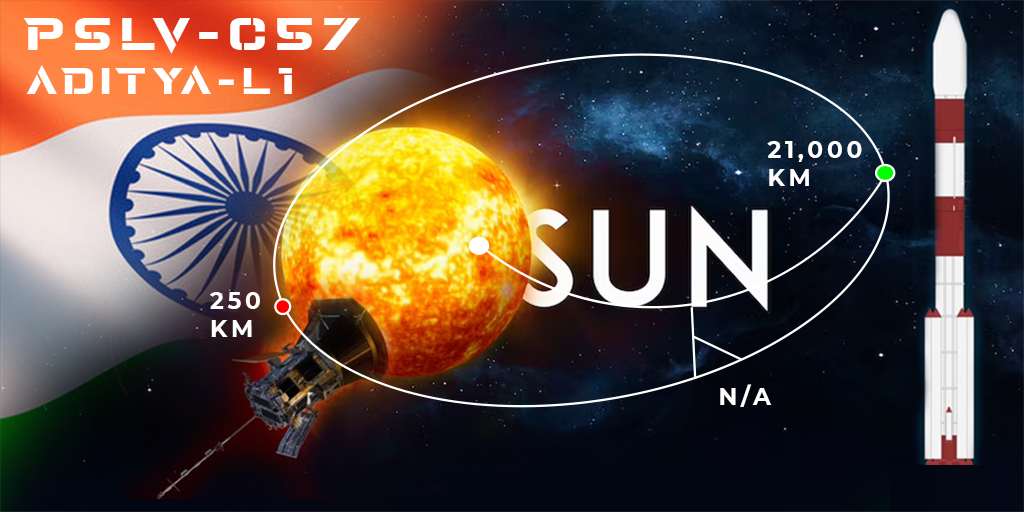Aditya-L1 Soars to Success: ISRO’s Maiden Solar Mission Launched Successfully by PSLV-C57″ ISRO’s “Aditya-L1, India’s maiden solar mission, achieved a momentous milestone on September 2, 2023, at 11:50 AM.
The launch took place from the Second Launch Pad of the Satish Dhawan Space Centre (SDSC) in Sriharikota, with the Polar Satellite Launch Vehicle (PSLV-C57) successfully propelling the spacecraft into its intended orbit.”

Aditya L1 is said to be India’s first space mission to explore the Sun.
The spacecraft will be in a halo orbit around the Lagrangian point 1 (L1) in the Sun-Earth system, approximately 1.5 million kilometers from Earth.
A satellite placed in a halo orbit around the L1 point has the great advantage of being able to observe the Sun continuously without obstruction or eclipse. This offers significant advantages when observing solar activity and its impact on space weather in real time. The spacecraft will carry seven payloads to use electromagnetic, particle, and magnetic field detectors to observe the sun’s photosphere, chromosphere, and outermost layer (corona). Using L1’s dedicated viewpoint, four payloads will stare directly at the Sun, while the remaining three will conduct particle and field studies at L1’s Lagrangian point location, investigating the propagation of solar dynamics in the interplanetary medium. It provides important insight into effectiveness. Presentation of scientific research
The Aditya-L1 payload suit is expected to provide the most important information to solve problems like coronal heating, coronal mass jump, pre-flare, and flare activities and their properties, space climate dynamics, particle, and field emission, etc. to give There is
Science Objectives
The Aditya-L1 mission, India’s first solar mission, has several key science objectives aimed at advancing our understanding of the Sun and its influence on space weather and Earth. Here are the primary science objectives of the Aditya-L1 mission:
Study the Solar Corona:
Aditya-L1 aims to comprehensively study the Sun’s outermost layer, the corona. This region is of particular interest because it is much hotter than the Sun’s visible surface (photosphere), and understanding its properties and dynamics can help scientists unravel mysteries about the Sun’s behavior and energy transfer processes.
Investigate Solar Wind:
The mission seeks to investigate the solar wind, a continuous stream of charged particles (plasma) emitted by the Sun. Aditya-L1 will analyze the composition and speed of solar wind, helping scientists better understand its impact on Earth’s magnetosphere and space weather.
Understand Magnetic Fields:
The spacecraft will examine the Sun’s magnetic fields, both on its surface and in the corona. Solar magnetic fields play a significant role in the formation of sunspots, solar flares, and coronal mass ejections (CMEs), which can have substantial effects on space weather and Earth’s technological infrastructure.
Monitor Solar Activity: Aditya-L1 will closely monitor solar activity, including sunspots and solar flares, to gain insights into the Sun’s cyclical behavior and how it influences space weather patterns on Earth.
Coronal Mass Ejections (CMEs): The mission will focus on the prediction and monitoring of coronal mass ejections, which are massive bursts of solar wind and magnetic fields that can disrupt satellite communication, power grids, and other technologies on Earth.
Helioseismology: Aditya-L1 will conduct helioseismology studies to investigate the internal structure and dynamics of the Sun, including its oscillations and wave patterns. This research can provide valuable information about the Sun’s composition and energy generation processes.
Space Weather Prediction: By studying the Sun and its influence on space weather, the mission aims to improve space weather forecasting capabilities. This is crucial for safeguarding both space-based assets like satellites and technology on Earth, as well as astronauts in space.

Overall, the Aditya-L1 mission represents a significant step forward in our understanding of the Sun and its impact on space weather, helping to mitigate potential risks and enhance our ability to predict and manage space weather-related phenomena.





